
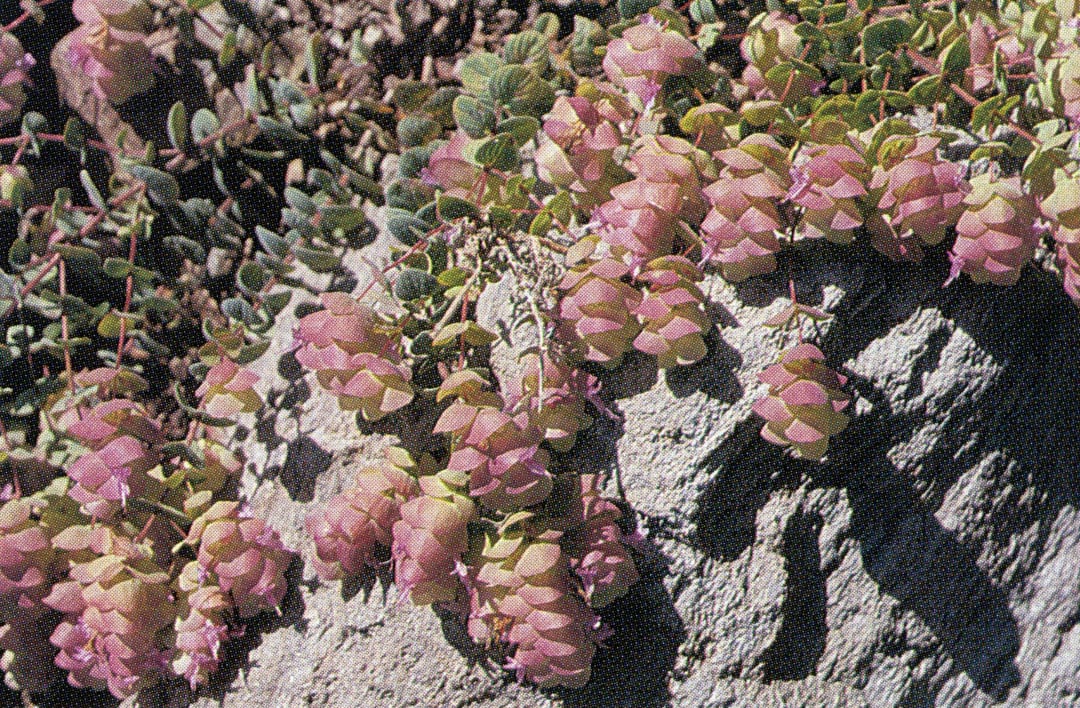
Contributor
- Topics: Archive, Plants You Need
Origanums are a group of subshrubs, or perennial herbs, some with arching or prostrate stems useful for trailing over rocks, banks, and walls. Wilhelm Schact, in Rock Gardens, says they are a great attraction for bees and butterflies, and look especially good with thymes, heathers, asters, and dwarf junipers.
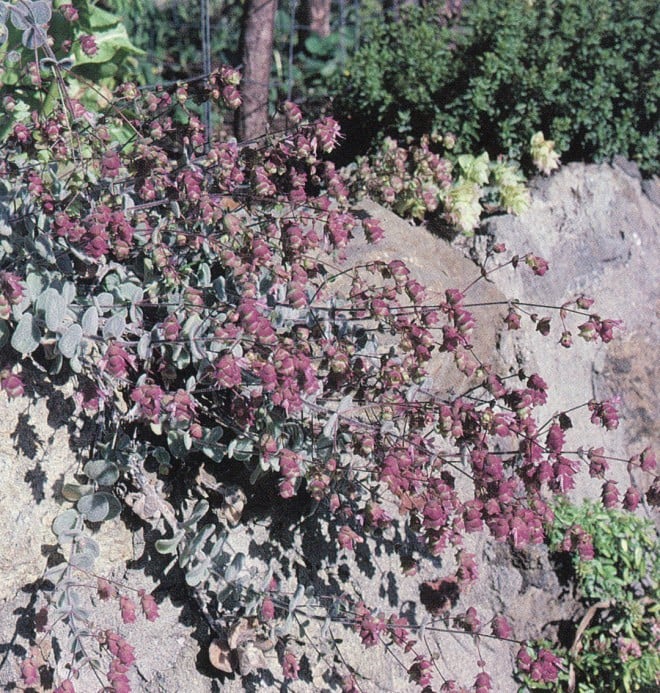
Over two thousand years ago Hippocrates used the name origanum, which comes from the Greek oreos (mountain) and ganeos (beauty or brightness). Thousands of years earlier some origanums, such as dittany of Crete (Origanum dictamnus) and sweet marjoram (O. majorana), were already valued as beneficial herbs. Today we are beginning to appreciate them again for their beauty as well as for the usefulness of the more flavorful species in the herb garden. Although a few have been grown in gardens for many years, in the last decade they have become increasingly popular as new species and hybrids have been introduced. Native to the mountains of the eastern Mediterranean, as most of them are, they have proven to be tolerant of both cold and drought, so they are ideal for gardens on the Pacific Coast, as well as on the high and dry plains of the mountain states.
In the big freeze that swept down from Alaska in February 1989, our own garden on the east side of the Berkeley hills, at 1,000 feet elevation, lost most of its Australian and South African natives, even some that were well established. Plants from the Mediterranean, including the origanums, came through without a casualty.
After the explosion of spring color in the garden has passed, origanums display their more subtle charms throughout summer and fall. Most origanum flowers are tiny, and it is the colorful bracts that are showiest in the more decorative plants. The bracts stay for months, forming hop-like spikes that gradually elongate. The deepest color, as well as the strongest fragrance, is found on plants that are in full sun for at least half the day. In nature origanums are found growing in rocky, calcareous areas, sometimes in the shade of trees. In cultivation they may not require added lime, but good drainage is essential. They abhor muggy conditions in summer and alternate freezing and thawing in winter, especially the woolly and hairy-leaved plants. This may explain why some origanums are considered tender in England and in the eastern United States, where conditions are much more humid than in their homeland and in Pacific Coast states.
As do many of the labiates, some origanums hybridize readily, as both bumble and honey bees are attracted to their aromatic blossoms. Experience has taught us to look with suspicion on the chance seedlings that pop up in a garden, so cuttings or divisions are more reliable if more plants of a particular kind are desired.
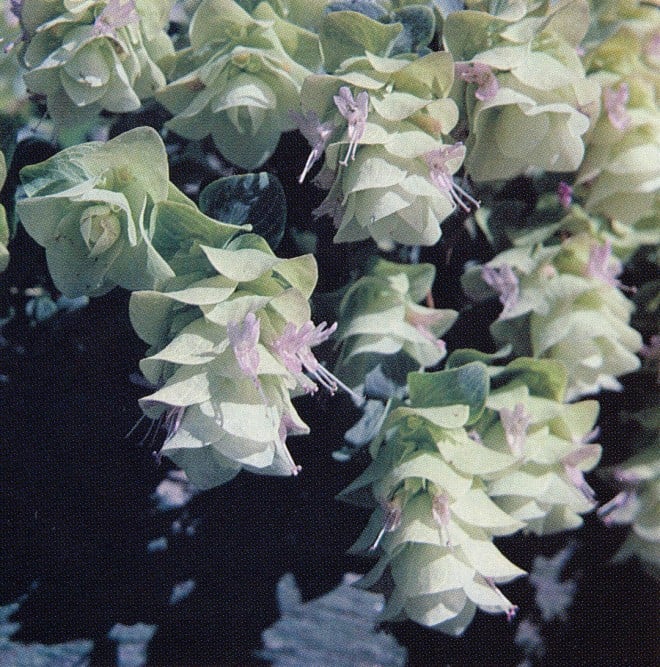
Some Garden-worthy Origanums
Origanum rotundifolium, its little white flowers tinged with pink and spikes more than an inch in diameter, is from the mountains of eastern Turkey and acclaimed by some gardeners as their favorite of all plants in the genus. Its round leaves are distinctly veined and slightly leathery. O. rotundifolium blooms for months, and in its season it is one of the first plants spotted by visitors to our Berkeley garden. It may be propagated by lifting rooted divisions from established plants, as well as by cuttings.
Origanum acutidens is a late-comer to this part of the world, seed having been collected in northeastern Turkey in 1986 by those peripatetic plant hunters, the Archibalds. The plant is closely related to O. rotundifolium, and in the garden the two look much alike. Both have chartreuse bracts, although those of O. acutidens have perhaps a more yellowish tint, and the pointed leaves of the latter are a little smaller. Some growers have found O. acutidens more temperamental than other members of the genus, but it has not yet been given wide enough garden exposure to determine its adaptability under varying conditions.
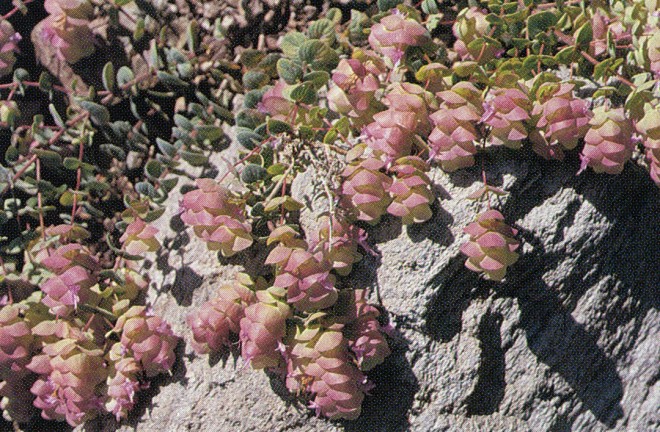
Origanum ‘Barbara Tingey’ and O. ‘Kent Beauty’ may be half sisters, both having the heavily veined leaves of O. rotundifolium, but the leaves of the more recently introduced ‘Barbara Tingey’ are leathery and the plant is evergreen while ‘Kent Beauty’ is herbaceous. ‘Kent Beauty’ is from an English garden, where it was selected from a number of chance seedlings growing near plants of O. rotundifolium and O. scabrum. From the latter plant, O. ‘Kent Beauty’ probably inherits both its deep purple bracts on flowering spikes and its habit of sending out long underground runners. After a time ‘Kent Beauty’ may spread over an appreciable area, but we cannot consider this beautiful hybrid invasive. ‘Barbara Tingey’, which does not send out underground runners, may be therefore more amenable to pot culture. It gives a bright splash of color from early summer into fall and gets an A-plus rating as an overall excellent plant.
Origanum scabrum, with bright purple bracts, arrived recently from the Denver Botanic Garden and has not been grown here long enough to give it a fair evaluation. Related to O. libanoticum and O. sipyleum, it is native to the mountains of the Peloponnese, in Greece, where Dr J.H. Ietswaart, who authored the first modern comprehensive study of the genus in 1980, reports that “it always occurs on limestone, in screes, between boulders and in cracks.” Fortunately, it seems to be comfortable enough here without all of those amenities, but it does need deep drainage.
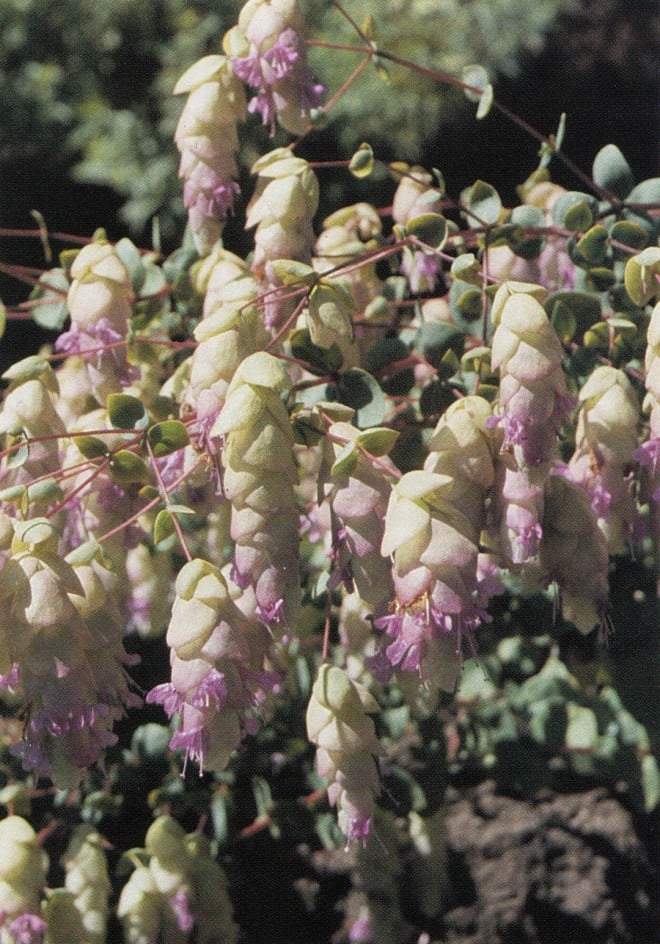
For many years Origanum libanoticum has been grown along the Pacific Coast from British Columbia to southern California. Its original source is uncertain, The California Horticultural Society gave this plant an Award of Merit in 1980 (under the misnomer O. “pulchellum”). Under any name it is a lovely addition to the garden and one of the least troublesome to grow. Its spikes begin blooming in June with just one or two pairs of bracts and, when summers are warm, continue to elongate well into fall, by which time they may be several inches in length. It is striking spilling down a bank where the bracts can be effectively displayed.
Origanum sipyleum, often confused with O. x hybridinum (of which it is one of the parents), has pink flowers peering out from slender spikes, which are smaller than some of its showier relatives. Though it flowers in summer, the heart-shaped leaves of this graceful shrublet add interest to the rock garden throughout the year. It is native to western Turkey, occurring in rocky areas, sometimes under pines.
Origanum x hybridinum
Origanum x hybridinum (O. dictamnus x O. sipyleum) and its cultivars have been grown in California for decades. O. x hybridinum was introduced into southern California in the mid-1940s, misidentified as O. dictamnus, the legendary dittany of Crete. Later a somewhat different plant by the same name came from Victor Reiter’s garden in San Francisco. Both were taken to Dr Philip A. Munz, at that time director of the Rancho Santa Ana Botanic Garden, then located on the old Bixby Ranch in the Santa Ana River canyon. After much searching through old herbals and gardening books, as well as more recent publications, Dr Munz decided that the specimen with round woolly leaves from northern California was O. dictamnus, while the other was O. x hybridinum. Many years later his identifications were confirmed by Dr Arthur O. Tucker, research professor at Delaware State College in Delaware, an eminent taxonomist specializing in the labiates.
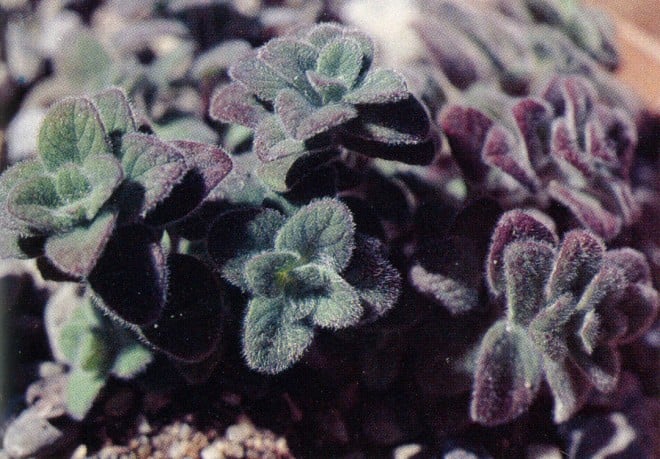
Origanum x hybridinum, described by Lester Hawkins as a “most graceful and airy plant,” has the tiny pink flowers and purple bracts forming hop-like spikes that are typical as well of its two cultivars. Its leaves are shaped like those of O. sipyleum, but they are somewhat woolly rather than smooth. The entire plant is more compact than its cultivars. It has often of late been called O. hybridum, but in his helpful revision of the genus, followed here, J.H. Ietswaart establishes the name O. x hybridinum.
Origanum x hybridinum ‘Ray Williams’ is easy to identify because of the cupped, roundish leaves it has inherited from O. dictamnus. It is also a more vigorous grower than other plants of O. x hybridinum, flowering abundantly on stems that are more than twice as long. It is particularly effective hanging over a wall.
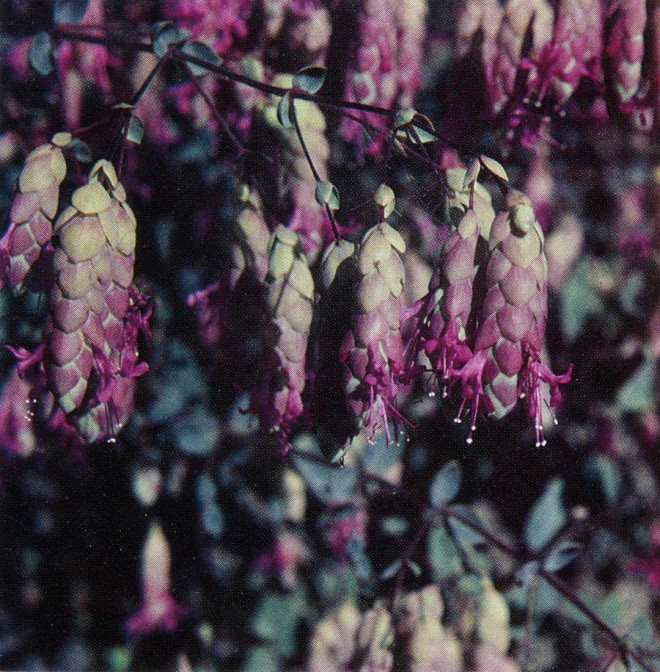
Origanum x hybridinum ‘Nancy Wilson’ seems to be intermediate between O. x hybridinum and O. x hybridinum ‘Ray Williams’. It was found in the garden of Nancy Wilson, who obtained it many years ago from Ray Williams. Williams raised most of his plants from seed, and on a visit to his Alpine Nursery near Watsonville, California, in the 1950s I remember observing distinct variations among his seedlings of this plant.
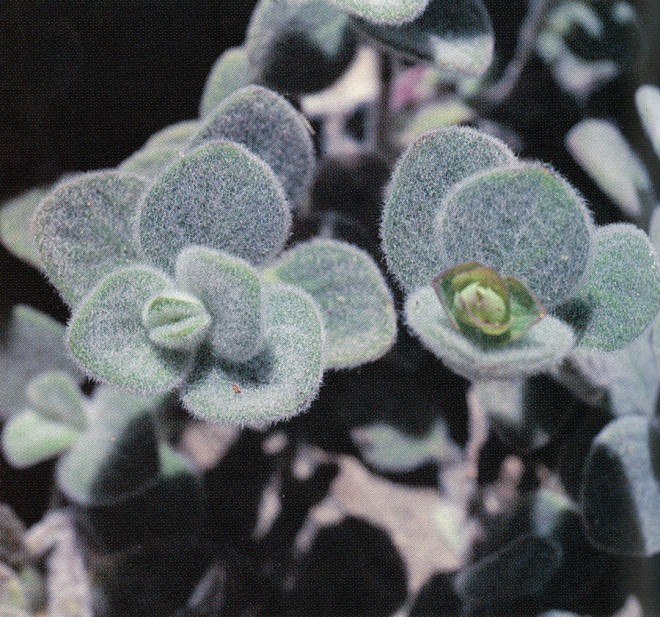
Dittany of Crete
Origanum dictamnus, with small pink flowers enclosed in long-lived ruby or purple bracts, is native to the mountains, where it is found in crevices in the limestone walls of caves and gorges, often in the shade. It has been cultivated in Europe for centuries and came to Pacific Coast gardens almost fifty years ago. Dittany of Crete was revered by the ancient Greeks and Romans for its healing powers. One particularly important virtue was its ability to drive spears and arrows from the body and cause immediate healing of the wounds — surely a persuasive reason to have it handy in the garden. It self-sows sparingly, and tiny plants may be found around the parent in spring. In our California garden it occasionally sows itself in cracks in cement paving, proving its love of lime, surviving unless a carelessly handled broom or misplaced foot destroys it. In spring 1986, as members of the Pacific Horticulture wildflower tour scrambled down Imbros Gorge on Crete, leader Christopher Brickell pointed out this dittany high on the vertical walls, well out of reach of the ubiquitous goats. Overcropping by man and beast has destroyed it in many of its habitats, and it is becoming rare in nature. On an earlier trip to Greece a local botanist mentioned past efforts to grow the plant as a commercial crop on Crete. The projects had failed. Apparently the dittany prefers the austere conditions of its rocky mountain home to the richer soil and impure air of lower elevations.
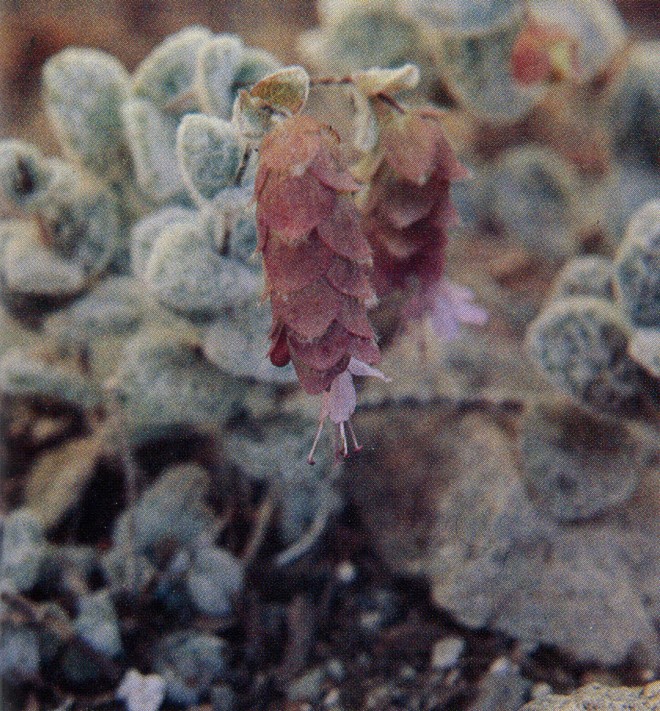
Some time ago a miniature plant of Origanum dictamnus, now called wee dittany, was discovered in the Pacific Northwest. Its leaves are barely a quarter inch wide, and the whole plant is equally diminutive. Its seeds are apt to yield full-sized plants, and the small plants now available are too young to yield good propagating material, but eventually this little treasure should find its way into special places in western gardens.
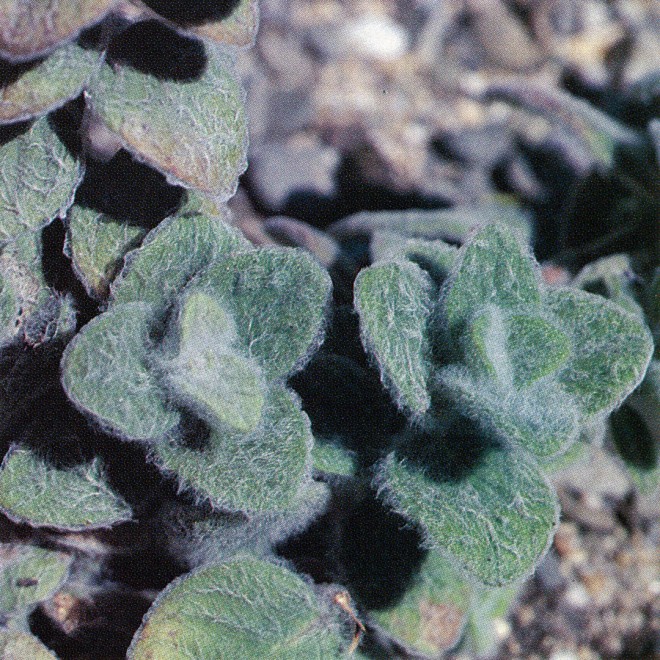
Origanum calcaratum (O. tournefortii, dittany of Amorgos, might at first glance be mistaken for O. dictamnus, to which it is closely related. But the round leaves of O. calcaratum are leathery and hairy and slightly greener than the woolly leaves of O. dictamnus, and its longer and more numerous flowering spikes with pink bracts make it a showier plant. Though the culture of both species is similar, some find O. calcaratum easier to grow. It occurs naturally at lower altitudes than most others of the genus, found from sea level to 2,200 feet on bare calcareous rocks inaccessible to grazing animals.
Marjoram
Origanum majorana (Majorana hortensis), sweet or knotted marjoram, has tight little flower buds and the whole plant has a delicious fragrance. The leaves are still flavorful when dried for the spice jar. It is found on Cyprus and the adjacent part of southern Turkey, as well as in Spain and Portugal and across the Straits of Gibraltar into northern Africa. O. majorana has been cultivated throughout Europe for two centuries as a medicinal herb, and today it is important in the kitchen garden for its many culinary uses. Though often treated as an annual, it persists for years in coastal California. Aristotle said that the tortoise protects itself by eating marjoram when it sees a venomous creature snaking up to it and that “this action has actually been observed.” Marjoram is reputed to have great power as a love charm.
Origanum x majoricum (O. majorana x O. vulgare subsp. virens) was grown in gardens for over forty years as O. majorana, until it was identified by Dr Tucker as a hybrid of that species. O. x majoricum, though similar in appearance to its parent O. majorana, makes a stronger and taller plant. It evidently inherits its sturdiness and cold hardiness from O. vulgare subsp. virens, its other parent, and therefore is an easy plant to grow. But its flavor is almost identical to that of O. majorana, which is probably why it has long been planted in the culinary garden to be used when a recipe calls for marjoram. O. x majoricum is found in the wild in southern Spain and Portugal, where both its parents also occur. When it came to this country is uncertain, but it is quite possible that Spanish settlers brought it to Alta California.
Origanum onites (Majorana onites), pot marjoram, is distributed over a wide area of the eastern Mediterranean, growing from sea level up to 4,600 feet. Plants have been in this country only since 1975. Reported tender in some climates, it seems to be completely hardy here, though in a warm wet winter in the early 1980s when El Niño pushed north we lost young plants to fungus or bacterial infections. However, our first plant is still growing on the slope it has occupied for twelve or thirteen years. The inflorescence of O. onites is particularly distinct. On a mature plant the flowering spikes form a flat corymbose head several inches in diameter, rather than elongating as they do in most of the more ornamental species. In Crete O. onites, called rhigani, is a favorite seasoning. When it becomes better known in America, this plant will be sought out by every herb gardener for its lovely aroma and bright peppery flavor.
Origanum syriacum (O. maru, O. maru var. aegyptiacum, Majorana syriaca) is native to the Levant. Two varieties are grown in this country: O. syriacum var. syriacum and O. syriacum var. bevanii. The stems of the former are woolly, while those of the latter are hairy. The species is closely related to O. majorana and O. onites, and all are delightfully fragrant. O. syriacum is believed by most authorities to be the hyssop of the Old Testament. From time immemorial it has been used medicinally, and more recently as a seasoning.
Oregano
Origanum vulgare, wild marjoram or oregano, is now the only species in the Section Origanum, according to Dr Ietswaart. Here are placed six subspecies, most of which had previously been regarded as species themselves.
Origanum vulgare subsp. vulgare has become naturalized in many parts of the United States, including California. Some plants with good red flowers are worth growing in gardens, but the plant can become rank and invasive, seeding itself freely. There are a number of distinctive cultivars, and two have golden leaves: O. vulgare subsp. vulgare ‘Aureum’ was first described by Parkinson in Paradisus Terrestris. Other than in the color of its leaves, it is very like other plants of the species. It makes a good ground cover and is colorful most of the year. The second golden-leaved cultivar is ‘Dr Ietswaart’. This plant requires more attention to keep its vigor. It has little roundish leaves, bright yellow in spring but fading to green if planted in shade. O. vulgare subsp. vulgare ‘Dr Ietswaart’ is widely grown in England as an ornamental edging for the front of the herb garden.
A dwarf cultivar, Origanum vulgare subsp. vulgare ‘Humile’, (O. ‘Compactum’ or O. ‘Compactum Nanum’) grows only a few inches high, with rare flowering stems rising slightly above the foliage. This makes an excellent low ground cover that does not seem to mind being walked on occasionally.
Origanum vulgare subsp. gracile is the name given by Dr Ietswaart to two plants named by another author, O. tyttanthum and O. kopetdaghense. In our garden, however, the two plants seem different. As they grow here, O. tyttanthum is the smaller and more flavorful of the two, and deserves a place in the herb garden. It is, overall, a smaller plant than O. kopetdaghense, which is similar in its more vigorous growth to O. vulgare subsp. vulgare. Both also have green bracts, but we have seen only white flowers on plants of O. tyttanthum, the seed of which came from two sources, Kirghiz and Tashkent in southern Russia. Seeds of O. kopetdaghense from Czechoslovakia produced plants with pink flowers and other plants with white.
Origanum vulgare subsp. hirtum (O. heracleoticum) looks much like O. vulgare subsp. vulgare, but its bracts are green instead of purple, its flowers are white rather than pink or red, and its leaves are deliciously pungent. It is undemanding, and rooted divisions may be easily pulled off from the parent plant. This is the origanum that gives the oregano flavor to our foods.
Origanum vulgare subsp. virens is native to areas around the western part of the Mediterranean Sea. It has yellowish green bracts and small white flowers. Its chief claim to fame is as one parent of O. x majoricum.
Origanum vulgare subsp. viride occurs widely across Eurasia, but it tends to merge into some of the other subspecies already described.
More Origanums
Origanum laevigatum was one of our first acquisitions from Ray Williams’ nursery, and it has thrived in our garden for nearly forty years. Its spikes are much smaller and quite different from the hop-like ones of some other origanums, being more like those seen in plants of the O. vulgare complex. It is particularly valuable for late-season color, blooming from midsummer well into winter in mild years. O. laevigatum has narrow bracts and rather small, smooth leaves, the loose spikelets fanning out to display the little pink flowers. Recently O. laevigatum ‘Hopley’ has been introduced to the Pacific Coast. This cultivar blooms several months before other plants of the species, and its spikes with pinkish purple flowers may be showier. We grow the two plants in different areas, and have not yet closely compared them.
Origanum amanum, one of the most coveted species, grows only a few inches high. Although it has attractive deep pink bracts, it is distinguished from others in the genus by its numerous, bright lilac-pink, long-lasting flowers, with corollas an inch or more in length. It has a reputation for being short-lived, but we acquired our first plant from the Denver Botanic Garden in 1984 and, growing in a bed of well drained sandy loam, it has survived in our garden ever since. O. amanum is herbaceous, and its disappearance in winter may lead to premature decisions about its demise. In the warming days of spring new shoots appear around the old plant, which itself also eventually shows new signs of life. It might also be that, moved to mild lowland gardens from its stern and rocky home high in the Amanus mountains of southwestern Turkey, its life is shortened by excessive flowering. Carefully cutting back stems after flowering should help prolong its stay in the garden. Roy Elliot describes this origanum as “one of the most beautiful plants that can be grown.” He suggests keeping replacements “constantly coming on, because one never knows when this superb plant is going to give up the contest. But never,” he says, “was propagation devoted to a better cause.”
Origanum dayi was introduced by the University of California Botanical Garden, Berkeley, from seed collected from plants growing in the desert-like Judean hills of Israel. The stiffly erect little shrub with tiny white flowers makes a modest appearance, but its delicious pungency, reminiscent of camphor, will recommend it to all who appreciate fragrance in the garden.
Origanum microphyllum, a little shrub from Crete, is one of the daintiest of the clan. In our garden it grows two or three inches high, with flowering stems rising several inches more. These are dark brown and wiry and are scattered with pairs of tiny silver leaves. Above them are the tightly packed gray bracts with wee purple flowers appearing for a long period in summer. Minute in all its parts, this is an appropriate addition to the rock garden, where its modest charms can be appreciated. O. microphyllum survives with little attention on our cool Berkeley hillside, though some gardeners closer to sea level have found it short-lived. On the Pacific Horticulture trip in 1986 it was seen as we descended from the Plain of Lassithi, Crete, growing wild on a dusty roadside at approximately 1,500 feet elevation.
Origanum microphyllum has proven to be especially promiscuous. Self-sown seedlings are often found where this plant grows in the vicinity of other origanums. While seedlings do show evidence of O. microphyllum parentage, most have larger leaves, and even a casual inspection will usually confirm them as hybrids. A number of these seedlings have been grown on to maturity, but so far I have seen none interesting enough to warrant introduction to other gardens.
Origanum ‘Santa Cruz’ was a happy discovery among the seedlings that appeared in the Arboretum of the University of California, Santa Cruz. For some time it was known simply as O. hybrid-UCSC. It is a vigorous plant that easily accommodates itself to most garden conditions. O. ‘Santa Cruz’ begins flowering in early summer, developing colorful spikes a quarter inch in diameter, which gradually elongate to over an inch in length as the season advances into fall. Its lilac-pink flowers peek out from between the bracts at the top of the spikes, which vary in color from green to deep pink or mauve, depending on the exposure. Its long branches are useful in dried arrangements.
Less than half the species and hybrids described in Dr Ietswaart’s A Taxonomic Revision of the Genus Origanum are currently in cultivation, but the list is gradually lengthening. As interest grows, more plants are being collected in their native habitats and attractive hybrids are appearing in local gardens. Some of these undoubtedly will merit introduction in the future.
Share:
Social Media
Garden Futurist Podcast
Most Popular
Videos
Topics
Related Posts

Ground Up Science for Greener Cities with Garden Futurist Dr. Alessandro Ossola
Spring 2023 Listen to the Podcast here. Alessandro Ossola is a scientist who gets very excited about the challenge of climate change allowing for an

Readying Urban Forests for Climate Realities with Garden Futurist Dr. Greg McPherson
Winter 2023 Listen to the Podcast here. “Going from the mow and blow to a more horticulturally knowledgeable approach to maintaining the landscape. And that

Welcome, Greywater, to the Garden
Summer 2022 Oh, summer: delightful warm air, tomatoes swelling on the vine, fragrant blooms on an evening stroll. When it’s warm and rainless, how is

Big Tree-Data and Big-Tree Data with Garden Futurist Matt Ritter
Summer 2022 Listen to the full Garden Futurist: Episode XV podcast here. We are in an environmental crisis right now in many parts of California








Responses